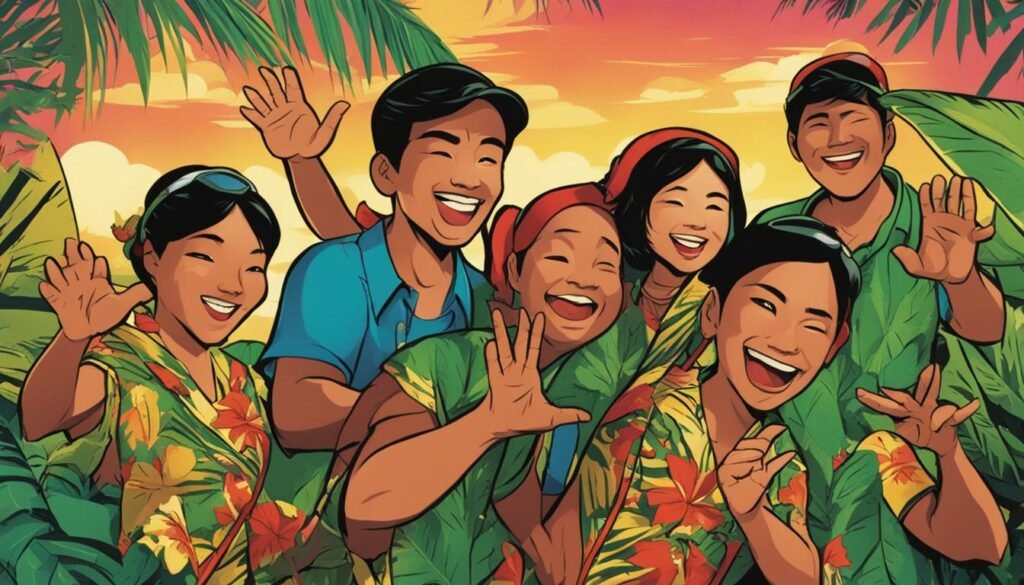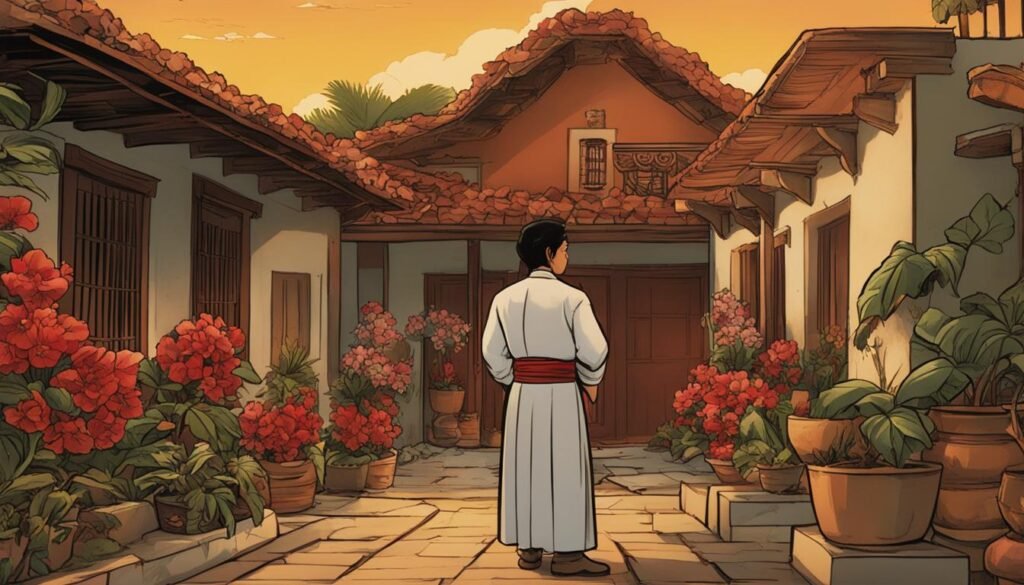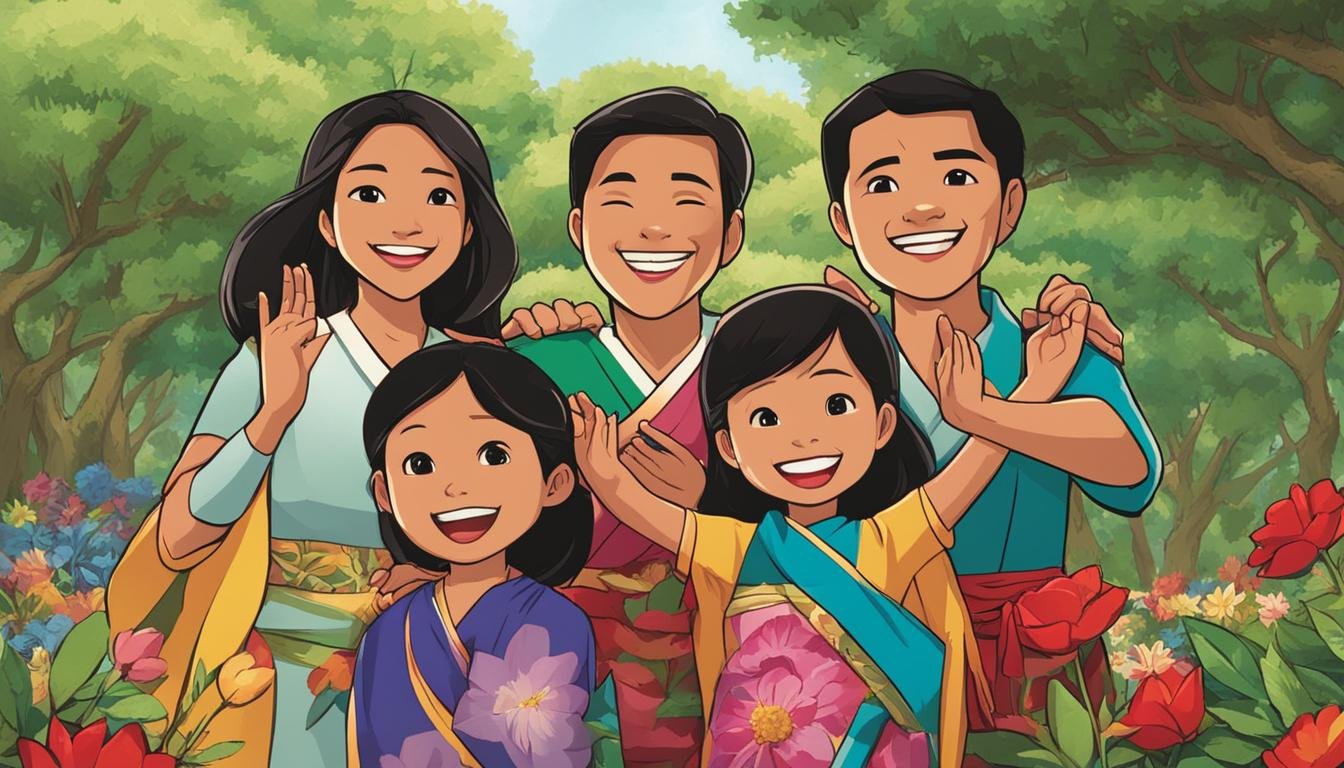Greetings play a crucial role in Filipino culture, reflecting the warm and friendly nature of the Filipino people. Knowing how to greet someone in the Philippines is not only a way to show respect and build connections, but it also allows you to fully embrace and appreciate Filipino culture. In this article, we will explore the various Filipino greetings, discuss their significance, and provide tips on how to greet in Tagalog, the national language of the Philippines.
Key Takeaways:
- The Philippines has a warm greeting culture, where hospitality and friendliness are highly valued.
- “Kumusta” is a commonly used Filipino greeting, which signifies “How are you?” Understanding its origins and variants is important.
- Filipino greetings are used throughout the day, with specific greetings for morning, afternoon, and evening. Maintaining warmth in greetings is essential.
- Knowing the difference between formal and informal greetings is crucial in Filipino culture. Politeness markers such as “po” and “opo” are widely used.
- English greetings, such as “hi” and “hello,” are also integrated into Filipino culture, especially in casual settings.
The Warm Greeting Culture of the Philippines
In the Philippines, warm greetings are more than just mere words. They embody the hospitality and friendly culture that the Filipino people are known for. Greetings play a significant role in building relationships and creating a welcoming atmosphere in the country.
Filipinos take pride in their warm and genuine greetings, which reflect their genuine interest in connecting with others. Whether you’re a local or a visitor, you can expect to be greeted with a smile and a warm welcome.
“Hospitality is ingrained in our culture. We believe in making people feel at home, even if they are strangers. Greetings are a way for us to show our genuine care and interest in others, and it sets the tone for the rest of the interaction.” – Maria Santos, a Filipino cultural expert.
From a simple “Good morning” to a heartfelt “Kumusta?” (How are you?), greetings in the Philippines are an invitation to open up and engage with one another.
The image above captures the essence of Filipino warm greetings, depicting a scene of a smiling Filipino welcoming someone with open arms. This image embodies the culture of warmth and friendliness that is deeply ingrained in the Filipino society.
Next, we will delve into the origins and variations of a popular Filipino greeting, “Kumusta,” and explore the common greetings used throughout the day in the Philippines.
Decoding Kumusta: The Filipino Welcome
In this section, we will explore the origins and cultural significance of the Filipino greeting “Kumusta.” Derived from the Spanish phrase “Como esta,” Kumusta is a warm and friendly welcome that is commonly used in the Philippines. Let’s dive deeper into the meaning of Kumusta and its comparison to the similar greeting Kamusta.
Origins of Kumusta
Kumusta can be traced back to the Spanish phrase “Como esta,” meaning “How are you?” The Philippines was under Spanish rule for more than 300 years, and as a result, the Spanish language has greatly influenced the Filipino culture, including its greetings. Over time, “Como esta” transformed into the Filipino greeting “Kumusta,” retaining its welcoming and inquiring nature.
Today, Kumusta is widely used across the Philippines and has become an integral part of Filipino communication. It reflects the warmth, hospitality, and genuine interest in the well-being of others that are characteristic of Filipino culture.
Kumusta vs Kamusta
Kumusta and Kamusta are two variants of the same greeting, often used interchangeably in the Philippines. While they have similar meanings and origins, there are slight differences in their usage.
Kamusta is the more colloquial form and is commonly used in casual conversations among friends, peers, or acquaintances. It is a simpler and shorter version of Kumusta, reflecting the familiarity and informality of the relationship.
Kumusta, on the other hand, is considered slightly more formal and is used in a broader range of contexts. It can be used in both casual and formal settings, making it a versatile greeting that can be used with individuals of different social or professional standings.

As we can see, both Kumusta and Kamusta provide a warm and hospitable welcome in the Filipino culture. Their usage may vary based on the level of formality or familiarity in the relationship, but both greetings reflect the genuine interest and care that Filipinos have for others’ well-being.
Common Filipino Greetings Throughout the Day
Filipinos are known for their warm and friendly nature, and greetings play a significant role in daily interactions. Let’s explore the common greetings used by Filipinos throughout the day and understand the importance of starting the day right with morning greetings in Tagalog, as well as keeping the warmth alive with afternoon and evening greetings.
Morning Greetings: Starting the Day Right
In the Philippines, starting the day with a cheerful greeting is considered essential. One of the most commonly used morning greetings in Tagalog is “Magandang umaga,” which translates to “Good morning” in English. Filipinos believe that exchanging positive greetings sets the tone for the day and fosters a positive atmosphere.
As the day begins, Filipinos greet each other with expressions like “Kumain ka na ba?” which means “Have you eaten?” This shows concern for the well-being of others and reflects the strong sense of community in Filipino culture.
Afternoon and Evening Greetings: Keeping the Warmth Alive
As the day progresses, Filipinos continue to share warmth and greetings. In the afternoon, a common greeting is “Magandang hapon,” meaning “Good afternoon.” It is a way to acknowledge others and wish them a pleasant afternoon.
In the evening, Filipinos greet each other with “Magandang gabi,” which translates to “Good evening.” This greeting is a way to show respect and acknowledge the end of the day. It’s common to hear Filipinos use this greeting when saying goodbye or when arriving at a social gathering.
Throughout the day, Filipinos use these greetings to create a welcoming and friendly atmosphere. Whether it’s starting the day off right with a cheerful “Good morning” or extending warm wishes with “Good afternoon” and “Good evening,” greetings play an important role in Filipino culture.
Formal vs Informal: Knowing the Difference
In the Philippines, it is important to understand the distinction between formal and informal greetings. These greetings vary depending on the level of politeness and familiarity desired in a specific context. By knowing when to use formal greetings and when to opt for more casual ones, you can navigate social interactions with ease and show respect to others.
When engaging in formal situations, such as business meetings, official events, or when addressing someone of a higher status or authority, using formal greetings is appropriate. Formal greetings convey a greater level of respect and professionalism. Examples of formal greetings in Tagalog include “Magandang umaga po” (Good morning, sir/ma’am) and “Magandang hapon po” (Good afternoon, sir/ma’am).
On the other hand, informal greetings are used in casual settings, among friends, family, or in informal conversations. These greetings reflect familiarity and a more relaxed tone. In informal situations, common casual greetings in Tagalog include “Kamusta” (How are you?) and “Kumusta” (How are you?). These greetings can be used with friends, peers, or when addressing someone of a similar status.

It is crucial to adjust your greetings based on the context and the relationship you have with the person you are greeting. Choosing the appropriate greeting shows cultural understanding and respect for Filipino traditions. So, whether you’re exchanging greetings in a formal or informal setting, remember to consider the level of familiarity, status, and professionalism required in each situation.
Using “Po” and “Opo” – The Hallmark of Politeness
In Filipino culture, the use of “po” and “opo” is considered a hallmark of politeness and respect in greetings. These two words play a significant role in expressing deference and showing proper etiquette in conversations.
“Po” is commonly used to address someone older or of higher social status. It is added to the end of sentences or phrases to convey respect. For example, instead of saying “salamat” (thank you), saying “salamat po” is a polite and respectful way of expressing gratitude.
“Opo”, on the other hand, is a formal affirmative response which acknowledges authority or agreement. It is often used to respond to someone older or in a position of power. For instance, when asked a question, replying with “opo” instead of “oo” is a way to show respect and deference.
The use of “po” and “opo” is deeply rooted in Filipino culture, reflecting the values of respect, humility, and politeness. It is important to use these words appropriately, especially when interacting with elders, authority figures, or unfamiliar individuals.
In addition to their use in greetings, “po” and “opo” can also be used in various conversational contexts to convey politeness. They help create a harmonious and respectful environment, fostering positive relationships and interactions.
Using “po” and “opo” not only shows respect but also demonstrates an understanding and appreciation of Filipino customs and traditions.
By incorporating these politeness markers into your greetings and conversations, you can effectively navigate social situations and convey your genuine respect for others.
Integrating English: The Ease of “Hi” and “Hello”
English greetings have seamlessly integrated into Filipino culture, forming a significant part of the daily greetings exchanged by Filipinos. In more casual or informal settings, Filipinos commonly use the English greetings “hi” and “hello” to greet one another. These simple and widely recognized English greetings have become a common way to initiate conversations and show friendliness in Filipino culture.
The ease of using “hi” and “hello” in Filipino greetings can be attributed to the strong influence of the English language in the Philippines. As a former colony of the United States and a country with a high proficiency in English, the Filipino society has embraced English as a second language, making it a part of everyday communication.
The adoption of English greetings has provided Filipinos with a broader and more diverse range of greetings to choose from, allowing for greater flexibility and expression in different social contexts. By using “hi” and “hello,” Filipinos can convey friendliness and approachability, creating an atmosphere of warmth and familiarity.

Greeting Elders Respectfully in Tagalog
Respecting elders is an integral part of Filipino culture. In the Philippines, there are traditional greetings and gestures specifically designed to show respect towards the older generation. By using these gestures and terms, you can convey your admiration and honor for elders. Let’s explore two significant aspects of respectfully greeting elders in Tagalog.
The Significance of “Mano Po”
“Mano Po” is a traditional Filipino gesture that demonstrates respect to elders. The younger person takes the elder’s hand and brings it to their forehead as a sign of deep reverence. This symbolizes acknowledging their wisdom, experience, and authority. “Mano Po” is often accompanied by saying “Mano po, bless,” which signifies the younger person’s request for the elder’s blessings and guidance.
This gesture is more than just a physical act; it also serves as a cultural symbol of respect towards elders. It is commonly performed when greeting parents, grandparents, and older family members. “Mano Po” signifies the humble recognition of the elder’s importance and the younger person’s willingness to honor and seek their blessings.
Gender-Specific Terms of Respect
In Filipino culture, gender-specific terms of respect are used to address elders politely. These terms show reverence while acknowledging the person’s gender. Here are some commonly used terms:
| Term of Respect | Meaning |
|---|---|
| Po | A term added after a person’s name or phrase to show respect and politeness. |
| Opo | A polite response affirming agreement or understanding. |
| Itay | A respectful term for a male elder, like “father” or “sir.” |
| Nanay | A respectful term for a female elder, like “mother” or “ma’am.” |
| Lolo | A term used to address a male grandparent or elderly man. |
| Lola | A term used to address a female grandparent or elderly woman. |
Using these gender-specific terms is a way of showing respect and acknowledging the older person’s role in the family and society. It creates a sense of warmth and closeness, reinforcing the value of intergenerational relationships in Filipino culture.
Addressing Someone for the First Time in Filipino
When encountering someone for the first time in Filipino, it is important to strike a balance between formality and cordiality. Filipino culture places a high value on respect and politeness, especially in initial interactions. Whether you are meeting someone in a formal or informal setting, knowing the appropriate greetings and salutations can help create a positive impression.
Initial Encounters: Balancing Formality and Cordiality
In formal settings, such as business meetings or professional events, it is customary to address someone using formal greetings. One common phrase used in these situations is “Magandang umaga/pagkakataon” (Good morning/Good day) followed by the person’s title and last name, if known. For example, you can say, “Magandang umaga, Ginoong/Senyor/Senyora [Last Name]” to greet a person formally.
On the other hand, in informal settings, such as social gatherings or casual encounters, a more relaxed approach can be taken. Polite salutations like “Kumusta?” (How are you?) or “Mabuhay!” (Welcome!) can be used to initiate conversation. These casual greetings convey warmth and friendliness while maintaining a respectful tone.
Introductions and Salutations
When introducing yourself to someone for the first time, it is customary to state your full name and offer a firm handshake. This gesture signifies sincerity and openness. Additionally, it is polite to address the person you are meeting using their honorific title and last name, unless given permission to use their first name.
Example: “Ako po si [Your Full Name]. Kinagagalak ko pong makilala kayo, Ginoong/Senyor/Senyora [Last Name].” (I am [Your Full Name]. It is a pleasure to meet you, Mr./Sir/Mrs./Ms. [Last Name].)
If the person you are encountering is of significantly higher rank or age, the respectful term “po” should be added after the greetings and salutations. This term is used to show deference and is a hallmark of Filipino politeness.
Example: “Magandang umaga, Ginoong/Senyor/Senyora [Last Name]. Ako po si [Your Full Name]. Kinagagalak ko po kayong makilala.” (Good morning, Mr./Sir/Mrs./Ms. [Last Name]. I am [Your Full Name]. It is a pleasure to meet you.)

By adhering to these guidelines, you can navigate first-time encounters in Filipino with confidence and respect. Remember to consider the context and adjust your greetings accordingly, ensuring a positive and culturally appropriate interaction.
The Influence of Spanish on Filipino Greetings
The Philippines has a rich history of Spanish colonization, which has left a lasting influence on various aspects of Filipino culture, including greetings. Spanish greetings continue to be widely used and integrated into the Filipino language, showcasing the borrowing from the Spanish language.
Spanish greetings such as “Buenos días” (good morning), “Buenas tardes” (good afternoon), and “Buenas noches” (good evening) are commonly heard throughout the Philippines. These greetings reflect the Spanish influence on the concept of time and the importance of acknowledging different parts of the day.

In addition to time-based greetings, Spanish expressions of politeness and respect have also been adopted in Filipino culture. For example, “Señor” and “Señora” are used as polite terms to address older individuals. These terms originated from the Spanish language and continue to be used as a sign of respect for elders.
The Spanish influence on Filipino greetings further demonstrates the cultural blending that has occurred throughout history. It highlights the interconnectedness of different cultures and the ways in which languages evolve and adapt to new contexts.
By embracing and using Spanish greetings in the Philippines, Filipinos continue to pay homage to their historical roots and honor the cultural diversity that shapes their identity. Spanish greetings have become an integral part of Filipino communication, further enriching the tapestry of greetings in the country.
Dialectal Differences: Hi in Various Filipino Languages
In the diverse and culturally rich country of the Philippines, greetings can vary greatly depending on the language or region. Each Filipino language has its own unique way of saying “hi” or greeting someone. These dialectal differences add to the richness and diversity of Filipino culture.
When exploring the regional greetings in the Philippines, it’s important to note that there are over 180 languages spoken in the country. Some of the major languages include Tagalog, Cebuano, Ilocano, Bicolano, Hiligaynon, and Kapampangan, among many others.
Let’s take a closer look at some examples of regional greetings:
“Kumusta ka?” – This is a common way to say “hi” in Tagalog, which is the national language of the Philippines. It is also widely understood and used in many parts of the country.
In the Cebuano language, which is spoken in the Visayas region, a common greeting is “Kumusta ka?” or “Kumusta ka na?”
In Ilocano, which is spoken in the Ilocos region, the greeting “Awan ti nagan mo?” which means “What is your name?” can serve as a polite way of saying “hi” to someone.
Other examples of regional greetings include “Musta ka?” in Hiligaynon, “Kumusta po kayo?” in Kapampangan, and “Mayad nga aga” in Bicolano, which is used as a morning greeting.
As you can see, the greetings across various Filipino languages reflect the cultural diversity and linguistic richness of the Philippines. These regional variations add depth and uniqueness to the way Filipinos greet one another.
Practical Tips for Using Filipino Greetings Effectively
When it comes to greeting in the Philippines, it’s important to understand the appropriate usage of Filipino greetings. Here are some practical tips to help you navigate the world of Filipino greetings:
When to Use Certain Greetings
1. Use “Kumusta” or “Kamusta” when greeting friends, family, and acquaintances. This is a common and casual way to say “hello” or ask “how are you?”.
2. Reserve “Magandang umaga” (Good morning), “Magandang tanghali” (Good afternoon), and “Magandang gabi” (Good evening) for more formal or respectful situations, such as when addressing elders, superiors, or individuals you have just met.
3. “Maayong buntag” (Good morning in Cebuano) and “Magandang hapon” (Good afternoon) are region-specific greetings commonly used in certain parts of the Philippines. Use these greetings if you are familiar with the local language or if you are visiting Cebu and other areas where Cebuano is spoken.
Understanding Contextual Nuances
1. Pay attention to the level of formality in the situation. Formal greetings are typically used in professional or formal settings, such as business meetings or official events. Informal greetings, on the other hand, are more suitable for casual social gatherings or when interacting with close friends and family.
2. Be mindful of the cultural expectations surrounding greetings. In Filipino culture, it is common to greet elders and individuals of higher social status with extra respect and politeness. This can be shown by using “po” and “opo” or by using specific terms of respect.
3. Consider the regional or dialectal differences in greetings. The Philippines is a diverse country with various dialects and languages. Take the time to learn and understand the greeting customs of the specific region or language you are encountering.
Remember, greetings in the Philippines are more than just words—it’s about showing respect, warmth, and friendliness. With these practical tips, you’ll be well-equipped to use Filipino greetings effectively in any situation.
Conclusion: The Art of Saying Hi in the Philippines
In conclusion, greetings play a crucial role in the rich cultural tapestry of the Philippines. By understanding the various greetings used in the country, visitors and expatriates alike can fully embrace the warm and friendly Filipino culture. From the traditional “Mano Po” gesture of respect for elders to the integration of English greetings like “hi” and “hello,” the Philippines offers a diverse range of ways to say hi.
Throughout this article, we have explored the origins and meanings of Filipino greetings, the distinction between formal and informal greetings, and the influence of Spanish and regional dialects on Filipino greetings. We have also shared practical tips on using greetings effectively, emphasizing the importance of understanding contextual nuances and adjusting greetings based on the situation.
By incorporating Filipino greetings into your interactions, you can show respect, build relationships, and create a welcoming atmosphere. Whether it’s starting the day on a positive note with a morning greeting or maintaining warmth and friendliness throughout the day, these greetings are a powerful tool in connecting with the Filipino people.
So, the next time you visit the Philippines or engage with Filipinos, remember the art of saying hi. Embrace the vibrant Filipino culture and use greetings as a way to express your admiration and appreciation for all that the Philippines has to offer. By doing so, you will not only enrich your own experience but also leave a lasting impression on those you meet.
FAQ
How do Filipinos greet each other?
Filipinos have a warm and friendly greeting culture. They commonly use greetings like “Kumusta” and its variants throughout the day to greet one another.
What is the importance of greetings in Filipino culture?
Greetings play a significant role in building relationships and creating a welcoming atmosphere in Filipino culture. They reflect the hospitality and friendly nature of Filipinos.
What is the difference between “Kumusta” and “Kamusta”?
“Kumusta” and “Kamusta” are essentially the same greeting, but “Kumusta” is the more commonly used form in Tagalog, while “Kamusta” is more common in the Visayan dialect.
What are the common greetings used by Filipinos throughout the day?
Filipinos have morning greetings to start their day positively and maintain warm greetings in the afternoon and evening to continue the friendly atmosphere.
When should I use a formal greeting and when should I use a casual greeting in the Philippines?
Formal greetings are appropriate when addressing someone of higher status or in more professional settings. Casual greetings are more commonly used with friends, peers, and in informal situations.
What is the significance of “po” and “opo” in Filipino greetings?
“Po” and “opo” are markers of politeness and respect in Filipino culture. They should be used appropriately to show deference, especially when conversing with elders or those in higher positions.
Do Filipinos use English greetings as well?
Yes, Filipinos often integrate English greetings like “hi” and “hello” into their daily conversations, particularly in casual or informal settings.
How do Filipinos greet elders respectfully in Tagalog?
Filipinos show respect to elders by performing the traditional gesture called “Mano Po” and using gender-specific terms of respect, such as “Ate” for older sister and “Kuya” for older brother.
How should I address someone for the first time in Filipino?
When addressing someone for the first time, it is important to strike a balance between formality and cordiality. You can use formal introductions or polite salutations depending on the context.
What is the influence of Spanish on Filipino greetings?
The Philippines was once under Spanish rule, and as a result, Spanish has had a significant impact on Filipino greetings. Many greetings in the Philippines have Spanish origins.
How do greetings differ across the various Filipino languages?
Greetings can vary based on the specific Filipino language or region. Different dialects have their own unique greetings, reflecting the diverse linguistic landscape of the Philippines.
What are some practical tips for using Filipino greetings effectively?
It is important to understand when to use certain greetings based on the situation or relationship. Additionally, being aware of contextual nuances will help you adapt your greetings appropriately.
Source Links
- https://my.christchurchcitylibraries.com/blogs/post/learn-philippine-greetings/
- https://www.filipinopod101.com/blog/2019/01/12/how-to-say-hello-in-filipino/
- https://ling-app.com/fil/hello-in-tagalog/

